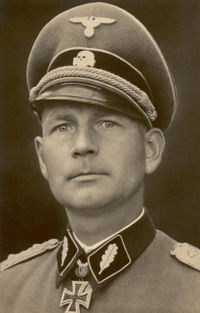Standartenführer


Standartenführer was a Nazi Party paramilitary rank that was used in both the S.A. and the S.S.. First founded as a title in 1925, in 1928 the rank became one of the first commissioned Nazi ranks and was bestowed upon those S.A. and S.S. officers who commanded units known as Standarten which were regiment-sized formations of between three hundred and five hundred men.
In 1929 the rank of Standartenführer was divided into two separate ranks known as Standartenführer (I) and Standartenführer (II). This concept was abandoned in 1930 when both the S.A. and S.S. expanded their rank systems to allow for more officer positions and thus the need for only a single Standartenführer rank.
In 1933, when Adolf Hitler came to power in Germany, the rank of Standartenführer had been established as the greatest field-officer rank, lesser that of Oberführer which was considered the first General's rank of the S.S. and S.A. By the start of the World War II, Standartenführer was widely spread as both an SS rank and a rank of the S.A.. In the Waffen-SS, the rank was considered the equivalent of an Oberst, a full colonel.
The insignia for Standartenführer consisted of a single oak leaf displayed on both collars. Standartenführer was the first of the S.S. and S.A. ranks to display rank insignia on both collars, without the display of unit insignia. From 1938, newer SS uniforms featured the shoulder boards of a German Oberst in addition to the oak leaf collar patches.
Fictional portrayals
- Standartenführer Stirlitz, the alias of Soviet spy Colonel Isayev - a hero of popular Russian books and a famous miniseries, one of the most famous characters of Russian jokes.
- Hans Landa, aka "The Jew Hunter" portrayed by Christoph Waltz in the film Inglourious Basterds.
- Ernst Vogel, the SS-Standartenführer from Indiana Jones and The Last Crusade. He is shown to be an SS Colonel by the collar patches on his uniform. (However, his uniform is neither a Waffen-SS or an Allgemeine-SS uniform. Allgemeine-SS uniforms, although of a similar design, were black)
| Junior Rank Obersturmbannführer |
SS rank and SA rank Standartenführer |
Senior Rank Oberführer |